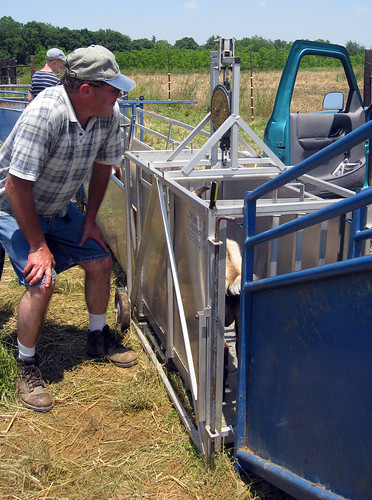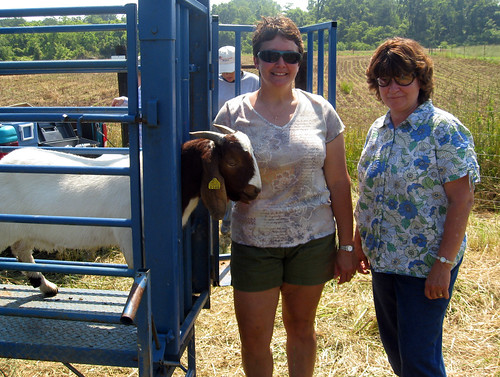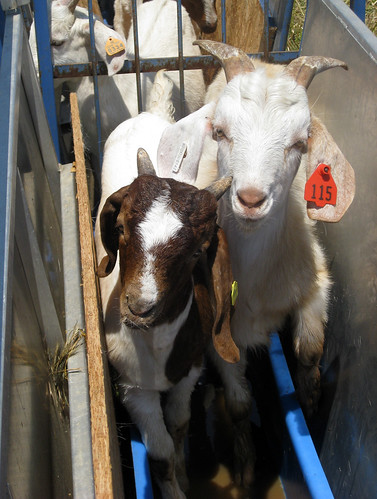Upon arrival at the test site, the goats were unloaded into the handling system. They were made to stand in a foot trough containing zinc sulfate (and wool) for 10 minutes. They were weighed by Willie Lantz. Weights ranged from 34 to 90 lbs. (15.5 to 40.9 kg). and averaged 49.9 lbs (22.7 kg).
 While on the work platform, the goats were dewormed with Cydectin® and Prohibit® drench. FAMACHA© eye anemia and body condition scores were recorded. FAMACHA© scores ranged from 1 to 4 and averaged 2.24. Body condition scores ranged from 2.0 to 3.5 and averaged 2.71. FAMACHA© and body condition scoring was done by Susan Schoenian.
While on the work platform, the goats were dewormed with Cydectin® and Prohibit® drench. FAMACHA© eye anemia and body condition scores were recorded. FAMACHA© scores ranged from 1 to 4 and averaged 2.24. Body condition scores ranged from 2.0 to 3.5 and averaged 2.71. FAMACHA© and body condition scoring was done by Susan Schoenian.Only three goats required deworming based on FAMACHA© scores. The purpose of deworming all of the goats is to make sure they start the test equally. The purpose of using anthelmintics from two different chemical classes is to make sure no resistant worms survive.
A fecal sample was collected by Dr. Dahlia Jackson. A pooled fecal sample was collected from random goats. Individual fecal samples will be analyzed by Delaware State University using the modified McMaster procedure to determine fecal egg counts (eggs per gram of feces). The pooled sample will be analyzed by the University of Georgia to determine specific egg types. Stomach worm egg types cannot be accurately identified in a fecal flotation.
 The heat was oppressive on June 7. The heat index (temperature + humidity) exceeded 100 degrees. It was a difficult day for both the goats and the handlers. Temperatures and humidity continue to be high. A break in the weather is not expected until mid-week. An additional shade structure will be provided to the goats. Water is fresh and plentiful.
The heat was oppressive on June 7. The heat index (temperature + humidity) exceeded 100 degrees. It was a difficult day for both the goats and the handlers. Temperatures and humidity continue to be high. A break in the weather is not expected until mid-week. An additional shade structure will be provided to the goats. Water is fresh and plentiful.The goats will be treated for coccidiosis (in the water) during the early part of the test. They will have access to free choice minerals containing a coccidiostat (Rumensin®).
The goats will be handled next on Friday, June 20. They will be weighed. This will be the official start weight, as the first 13 days of the test will serve as an adjustment period. The goats need to get used to their new diet, surroundings, and pasture mates. FAMACHA© and body condition scores will be recorded.
 Individual fecal samples will be collected, as well as another pooled sample. Since the goats were dewormed with two anthelmintics on June 7, it is not likely that any goats will require deworming. Hopefully, summer rains will provide a parasite challenge to the goats during the test. In 2006, the need for deworming peaked on August 4. Last year, the need for deworming was practically non-existant, as a result of drought conditions.
Individual fecal samples will be collected, as well as another pooled sample. Since the goats were dewormed with two anthelmintics on June 7, it is not likely that any goats will require deworming. Hopefully, summer rains will provide a parasite challenge to the goats during the test. In 2006, the need for deworming peaked on August 4. Last year, the need for deworming was practically non-existant, as a result of drought conditions.The goats on test are percentage and full blood Kikos and Boers, Kiko x Boer, and a few other crosses. They are all bucks. The top 20 performing bucks (based on growth, parasite, and ultrasound carcass data) will be eligible to sell on October 4 at the 1st Western Maryland Goat Field Day and Performance Tested Buck and Invitational Doe Sale.
The Western Maryland Pasture-Based Meat Goat Performance Test is sponsored by the University of Maryland. It is conducted at the university's Western Maryland Research & Education Center (WMREC) in Keedysville, MD.
Download report from June 7, 2008
Pictures from the test site (on Flickr)











